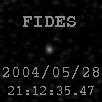Occultation de TYC 6783-00143-1 par l'astéroide (37) Fides.
le 25 mai 2004, 21:12 UTC.
Circonstances de l'événement:
(from Jan Manek's prediction pages http://mpocc.astro.cz/updates/)Matériel utilisé
Tak FS102, f/D8Webam VP, modifiée, N/B, mode raw
acquisition avec qastrocam sous linux
poses de 1 s, gain maximum.
Extrait de la séquence entre 21:12:40.48 et 21:12:54.47 :















Animation

Analyse des images :
 From fmeyer@obs-besancon.fr Wed Jun 2 14:41:25 2004
From fmeyer@obs-besancon.fr Wed Jun 2 14:41:25 2004Date: Tue, 1 Jun 2004 09:44:57 +0000 (UTC)
From: Francois Meyer fmeyer@obs-besancon.fr
To: PLANOCCULT@AULA.COM
Subject: Re: [PLANOCCULT] Fides positive on 2004/05/28
Here are some details about the methods and hardware used for Fides :
the webcam is a modified Philips Vesta pro with a
b/w sensor (ICX098BL) that is 3 times more sensitive than the original
colour ICX098AL chip.
The firmware has been tampered with to allow access to the raw image
(see for example Etienne Bonduelle's page) ; moreover,
two software filterings (one called "sharpness" and the other one called
"noise") that are out of control with the Windows driver, can be
controlled (and essentially disabled) under Linux ; this greatly
improves image quality when in limit of detection.
I have made tests at primary focus of my tak fs102
c/d8, with gain at full range (what is possible on the VP while it is
awfully noisy on the toucam; these 2 types of webcams have rather
different preamplification settings) on a field in m67.
At 5 im/s, it clearly shows stars up to mag(r)=11. I will put these
images online and publish the address here if people are interested.
If it wasnt for the low elevation (14°) of the 05/28 event, it is not
impossible that it could have been recorded at 5 im/s, allowing better
timing accuracy.
Instead I had to go with 1s exposures. But an 8" OTA could most probably
have done it, allowing timing the event with a 0.2s resolution.
I am waiting for clear skies to test if the target star for the Kalliope
event will be visible at a 5
ca/s rate despite of an even lower (10°) elevation, but with a less
faint star.
Timing :
image acquisition was made on a PC/linux box directly connected to the
internet. The PC operates an ntp server at stratum 2. This means that
both phase and frequency of the PC clock are servoed to a stratum 1
server (ie saturne.obs-besancon.fr, that I operate at work).
This is very different from using ntpdate to synchronise on an ntp
server, and it is of course far more reliable, time inaccuracy during
the event did never exceed 8 ms.
Timing the images :
images were timed by the acquisition software upon reception of the
camera signal that triggers image download, indicating that the image is
ready. A remarkably constant offset of .24 s (sigma lower than 0.01s)
between has been measured and corrected. This is the probably the main
source of error because this offset is probably hardware dependent and
measuring it requires some care.
I think this shows what a b/w modified webcam can do in that domain of
application :
At 4" of aperture, .2s accuracy is likely to be reached for events
involving stars up to mag(r) 11. Higher power OTAs will obviously do
better.
I will try to image the Kalliope event with a 10" newton in the same
setup, if weather allows it.
Clear skies.
fm, 2004/05/30



